Scoutmaster Musings
Archives:
2023 2022 2021 2020 2019 2018 2017 2016 2015 2014 2013 2012 2011 2010 2009 2008 2007 2006 2005
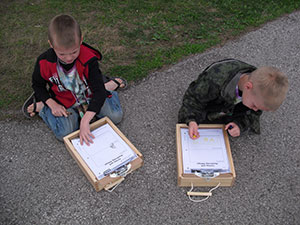
 Looking for some service conservation projects for 2017?
Looking for some service conservation projects for 2017?There are TONS of opportunities for volunteers to help out, from computer data entry to banding woodcock chicks - whatever your ability or interest.
Here's a few from MN DNR:
- Eagle Project? Field desks for kids to use in outdoor classrooms.
- Pull wild parsnip.
- Count loon populations.
- Trail Monitor - remember hall monitors in grade school?
- Scientific and Natural Area volunteer - collect seeds, plan seedlings, remove invasives, and more.
- Eagle Project? Make Tree Cookies.
- Monitor lake levels.
See MN DNR Volunteer Ops for these and more ideas.
| Leave Comment |

 A tiger den joined my Pen Pals program and included code for a tiger emoji in their name. I thought that was quite creative so I went looking for other emojis that might be useful, or at least fun.
A tiger den joined my Pen Pals program and included code for a tiger emoji in their name. I thought that was quite creative so I went looking for other emojis that might be useful, or at least fun.Fleur-de-lis = ⚜
Lion = 🦁
Bobcat = 🐱
Tiger = 🐯
Wolf = 🐺
Bear = 🐻
There is a very long list of emojis here and other places on the net.
These emojis may or may not display correctly depending on the capabilities of the device you are using to view this page.
Any other Scouting-related emojis out there? Try to include them in your comment.
| Leave Comment |

 You should view this announcement about gender identity by the BSA Chief Scout Executive today so you are keeping up with changes in the organization's processes - BSA video
You should view this announcement about gender identity by the BSA Chief Scout Executive today so you are keeping up with changes in the organization's processes - BSA video| See 6 comments | Leave Comment |

 I've had the good fortune to learn from a lot of good men while volunteering in the Boy Scouts of America. They range from professional artists to scientists, some with a high school diploma and others with too many letters after their name to list. They all have interesting stories and valuable experience to share.
I've had the good fortune to learn from a lot of good men while volunteering in the Boy Scouts of America. They range from professional artists to scientists, some with a high school diploma and others with too many letters after their name to list. They all have interesting stories and valuable experience to share.One Scouter in particular that I know has had a very eventful career, and this year was the keynote speaker at the Northern Star Council Million Dollar Day event. Dr. Andrew Baker provided terrific leadership and support to our troop while his sons progressed through the program. Dr. Baker is a great example of how Scouting can help a boy become a better man.
If you have just 13 minutes to spare, Dr. Baker shares his international experiences, Scouting impact, and how not to go winter camping.
Scout On
| Leave Comment |
Actual Failing would be dropping out of the program without gaining anything significant from it. That is something adult volunteers should definitely NOT let happen, but it is often our fault because we don't provide appropriate challenge to individual scouts.


The Scouting program succeeds by challenging scouts to push their abilities. What is challenging for one scout may be boringly easy or frustratingly difficult for another. One scout may be ready to navigate 30 miles, cross-country, in a blizzard, at night. Another may be challenged to point north at high noon. Our challenge is to challenge each scout in ways that help avoid failure.
This simple graph keeps me focused on this concept. The slope is the difficulty of what the scout is being expected to do - the steeper the slope, the more difficult that activity. Every scout (every person) has a built-in graph like this, set specifically to their interests, abilities, and aptitudes. If too little is asked, it's boring and I'll find something else to do. If it's easy, I won't learn much new but I can help others. If it's challenging, I gain from it and can help others gain a little, too. If it's strenuous, all my effort will be to learn and I won't be helping others. If it's so difficult for me that it is frustrating, I'll not learn it and most likely eventually find something else to do that is fun.


As scouts gain skills and experience, their graph will get steeper. Those activities that were challenging may now be boring.
No activity will fall into the challenging area for every scout, but it may be easy, challenging, or strenuous for nearly all of them. That allows most of them to gain something from the activity. We get into trouble when activities are always geared at the same center of mass for the troop - those advanced scouts get bored of things always being easy and inexperienced scouts get tired of never doing very well.
Patrols of similar-aged scouts allow a smaller group with more closely matched skills to do activities together. This removes a lot of the frustrating, easy, and boring areas. Some scouts will be ahead or behind their patrolmates, but not as much as an entire troop.
High adventure treks help with advanced scouts falling in the easy area too often. Finding other ways to challenge them is important. Constantly asking them to "help the younger scouts" gets old fast.
The ultimate way to ensure each scout is properly challenged would be to track his current skills, interests, and needs, and then have a way to map that to planned activities so every scout gets exactly what he needs. I don't think that's practical, but holler if you've figured out how to do it. Instead, we can plan opportunities that will help nearly everyone.
Other ways to help keep scouts in the challenging zone:
- Talk with each scout. Be aware of his current rank and what he should be generally working towards next. Be aware of what he tends to find easy or difficult, whether it's public communication or knots.
- Hold Skill Sessions for a set time at troop meetings or campouts where any scout can get help with up to First Class skills. Either advanced scouts or adults (if no scouts know the skills) provide the help.
- Create incentives for scouts to help others. Some advancement requirements include this, but there are other ways to make helping "the younger scouts" more fun. Just keeping a sheet of signatures from every scout that comes to him for help might be enough for some scouts, or a prize for every 10 or 20 scouts helped, or a spoof merit badge, or a public Thank You at courts of honor.
- Be a Lurker. On outings, don't just sit and drink coffee. Watch the scouts and keep an eye out for ones that appear uninterested or frustrated, especially when skills are being put to use.
- Any other ideas? Share as a comment below.
As the graphs tend to show, Discouragement is a much easier target to hit than Motivation. It's important to make efforts to keep Scouting time focused close to that challenging zone for every scout.
| Leave Comment |
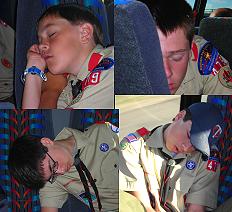

Already tired of winter vacation?
Bored with your current job?
The week after Christmas is a great time to think about new opportunities. As a scout with lots of outdoors skills, leadership qualities, and interpersonal communications, there are lots of openings for you to work in exciting, adventurous settings.
Whether you are a high school or college student, or looking for full-time work, there are many needs across the country that you can take on. Here are a few...
All the BSA high adventure bases need staff every year:
More BSA jobs:
Outside of the BSA program, there are even more jobs that a Scout might find interesting, challenging, and rewarding:
- Boundary Waters Outfitter
- Appalachian Trail Ridge Runners interact with A.T. hikers to improve the trail experience.
- National Park Service has thousands of outdoor jobs.
- Forest Service
- Department of State has a long list of sites where you can find outdoors jobs.
- Coolworks lists outdoor jobs


If you don't want to work this summer, you could Hike a Long Trail or Bike across the country.
Or, you could always stock shelves at the local grocery store. I did it, most boring job I ever had.
Scout On
| Leave Comment |
This is a sponsored post written by me on behalf of WASPcam. All opinions are 100% mine.

Who takes pictures and records your outings?
I have hundreds of photos that we've used in slide shows, web posts, ceremonies, and recruiting. It's fun to occasionally send an old photo to a past scout that is now out in the real world. He gets a kick out of seeing himself and his buddies as 'kids'. But, most of those shots are of static scenes since I've not been able to participate and record the activity at the same time.
To really share the adventure and excitement of a fun outing, video works much better than photos. Action-Sports cameras capture first person participation and put the viewer right in the adventure - and it's easier than you might think. The new WASPcam 9907 4K camera does an exceptional job of replacing your old digital camera with high quality videos. And, it's so small, sturdy, and easy, you can pass it off to a scout to record the more extreme activities your troop does.
This WASPcam records High Definition video in 1080p, 2K, or 4K with many programmable options such as time-lapse, motion detection, and loop recording. It also takes up to 20megapixel still photos in single, burst, or time delay mode. For extra control, it has WiFi connectivity and a smartphone app that allows you to remotely control the camera so YOU can be in the picture or video with your gang.
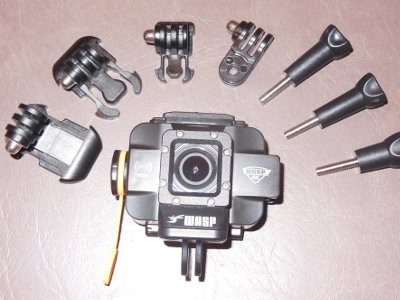
A key feature of the WASPcam 9907 4K is that it is waterproof - without requiring an extra case. This means snow sports, water sports, fishing trips, and rainy campouts are no longer a concern.
The camera itself is small and light (about 5oz.), and stealth black color. It comes with mounting fixtures to adhere it to your helmet. There are also a wide range of camera mount options so you can easily swap it between your helmet, handlebar, dashboard, tripod, surfboard, chest, head, or even your dog's back, whatever makes sense for the moment.
I've found that videos when mounted on a helmet or person are much smoother than when directly attached to handlebars or vehicle since the person absorbs a lot of the bumps and jolts of the trail.
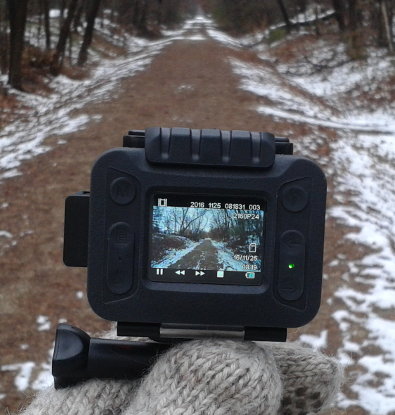
I found this camera to be very easy to use and a huge win over my digital camera and smartphone pictures and videos. It's very cool how crisp the images are, even moving activity. I really like the time lapse video, compressing an hour into a minute or less by taking a frame every 1, 3, or 5 seconds. The motion detection feature lets you set it and automatically catch .5, 1, or 5 minutes of any activity that happens, whether it's an animal walking by or hikers passing on the trail. I've included a snip of these below.
So, my favorite features of this action camera are:
- Waterproof and sturdy so it's usable anywhere with no concern about weather or rough handling.
- Range of recording options to change image clarity and storage use.
- 20MP photos are big and sharp.
- It's small, unobtrusive, and mountable many different ways.
This item would make a great gift for anyone that spends time outdoors and likes to share their adventures. There are a few things that I didn't enjoy:
- The automatic motion detection mode seems to only notice movement just a few feet away. A deeper range would be more useful.
- The optional smartphone app wasn't as useful as I hoped. It only starts and stops video recording and snaps photos, but you get to be in the picture!
- The user manual is unusable for me because of the tiny font, but here's a link to the User Manual PDF which is fine.
There's a video of my impressions of the camera on youtube with unpacking, setup, and sample video captures.
| Leave Comment |
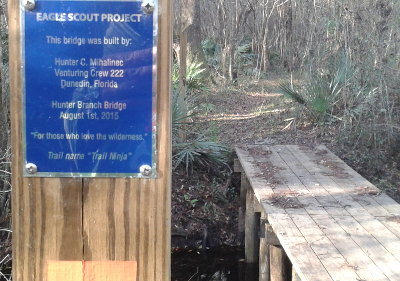

The National Forest System Trails Stewardship Act just became law! So?
Well, it directs the USDA to significantly increase the role of volunteers in trail maintenance projects. That means more opportunities for scouts to step up and provide assistance to the Forest Service to improve trail access to national public lands. Your scouts can contribute through eagle service projects, Hornaday projects, or general conservation work.
One of the most fun camping trips I've done was 3 days with a handful of scouts building part of the North Country National Scenic Trail.
This Act directs the USDA to figure out how to get more volunteers, have volunteer opportunities, and increase volunteer trail maintenance by 100% in 5 years.
They will also identify about a dozen areas where the lack of trail maintenance is severely affecting access to public lands, and work on fixing those problems. This could be blowdowns, eroded trails, anything that is preventing trail usage.
Plan Ahead Now - start thinking about conservation work your scouts can do next spring and summer. Contact your local USFS folks - start at the Region Office and ask them about how you can help.
PS: Did you know that two beings have their own personal zip codes in the United States? One is the president. Post a comment when you figure out who the other is.
| See 3 comments | Leave Comment |
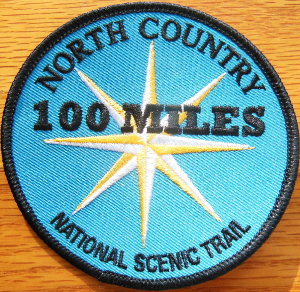

Check out my North Country Trail 100 Miles patch! Any scout can receive this patch and certificate by hiking at least 100 miles on the North Country National Scenic Trail by the end of 2016. So, you've got a month remaining to get out on the trail and rack up some miles.
You can walk the same mile of trail back and forth, or start hiking and keep it up until you've gone at least 100 miles. That's not hard for a lot of scouts in the northern part of the country since the NCT is 4,600 miles long from the New York/Vermont border to the middle of North Dakota. I did my 100 miles on the Superior Hiking Trail, completing 85 miles with a friend on a 5-day backpacking trip and then the other 15 miles on pieces of the trail through Duluth. The Superior Hiking Trail, Border Route Trail, and Kekekabic Trail are all part of the NCT in Minnesota.
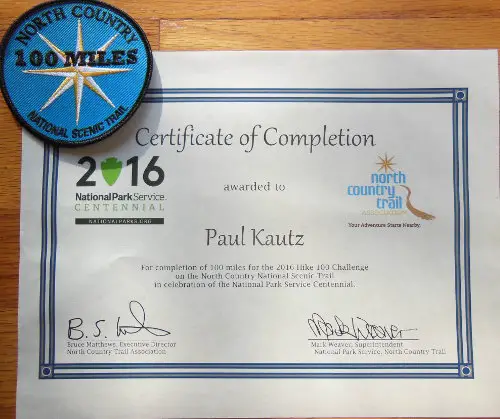

Snowshoeing, running, and walking are all legal ways to do your 100 miles. Weekend hikes in December or a longer trip after Christmas will get you through the challenge. You can read more details about the NCT Challenge.
If you've already hiked some miles on the NCT route, push it to finish it! A couple weekends could do it.
Scouts working on the Hiking, Camping, or Backpacking merit badges, or the National Outdoor Badges for Hiking, Camping, or Adventure can get even more out of miles on the NCT.
You might even win some very cool gear for your camping adventures next year.
#Hike100NCT
| Leave Comment |


Everyone I know that camps has been at least a bit scared by something going bump in the night. My scare was one night on the Arizona Trail, all alone, when I heard coyotes howling - not from one direction, but all around me. My tiny little silnylon tent didn't feel like much protection that night.
New campers can feel a lot more comfortable with just a slight bit of illumination to fight back the utter darkness in a forest with no city light pollution in the sky. Whether it's his first year at scout camp or first wilderness backpacking trip, the UV PaqLite can help a scout relax and get some rest out in the wilds.


The PaqLite is a vacuum sealed, flexible package of glow-in-the-dark crystals (strontium aluminate) that absorb light and then slowly release it as a green glow for hours. Shining a flashlight on this and then hanging it in a tent gives off a reassuring light until everyone is asleep, and it will still be glowing if someone wakes in the middle of the night.
The UV PaqLite provides comfort without wasting hours of flashlight batteries. A bright, overpowering light really isn't helpful at night, but a soft glow is perfect. This night light is a very thin 6x7 inches, weighs just about 1 ounce, can be rolled, folded, or crunched into any small spot in your pack, and illuminates a 3 person tent nicely.
Enough glow is thrown out so you can actually read by it for about an hour or so, but it does fade over time. A quick shot from a flashlight under a cover (to not bother tentmates) and hang it back up will give more time.
As you can see in the image, the crystals come in various packaging. The PaqLite is the large rectangular item. You can also get small amounts of crystal embedded in clear, poured epoxy so they are indesctructable, solid, and reusable indefinitely. These are good to hang on pieces of gear you might want to find in the dark. These hard packages come in various sizes and shapes, and you can cut and drill them to make smaller zipper pulls or whatever.
It's a night light for camping without the disposable waste from snap glow sticks - maybe a good little stocking stuffer?
| Leave Comment |

 Looking for a fun winter activity for a Webelos den? The US Forest Service has a Junior Snow Ranger program that you can use in a den meeting. This PDF file is a great activity book with an application form at the end. It covers science, animals, safety, and a lot more.
Looking for a fun winter activity for a Webelos den? The US Forest Service has a Junior Snow Ranger program that you can use in a den meeting. This PDF file is a great activity book with an application form at the end. It covers science, animals, safety, and a lot more.Scouts can receive a card, badge, and bandanna upon completing the program.
| Leave Comment |
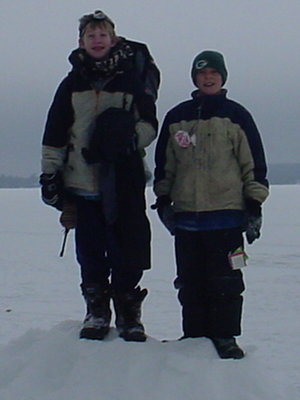

It's that time of year when all good scouts take on the extra challenge of camping in cold weather. Whether 'cold' to you is 30 degrees or -30 degrees, preparing and educating scouts is a big part of a successful outing. Here's a few ways to help remember important information...
WWWW - Wicking, Warmth, Wind, and Water are the Ws of dressing for cold weather camping. When dressing for cold weather, LAYERS are key to warmth and safety. The goal is to stay warm and dry.
A wicking layer against your skin pulls moisture away so it can evaporate and your body stays dry. This layer is polypropylene long underwear.
A warmth layer is a fluffy insulation around your body to keep the heat you generate trapped. This can be wool, down, fleece, or other light, fluffy jacket or vest.
The wicking and warmth layers need protection from wind and water. Wind can blow the trapped warmth away from you, and water can negate the insulation properties of your jacket. So, the outer layer is a waterproof barrier that also stops wind. This can be a raincoat, poncho, snow jacket and pants, or similar.
COLD - Clean, Overheat, Layers, Dry are four words to remember so you don't get cold when winter camping. Clothes that get dirty insulate less which makes you colder, so keep them clean. Overheating causes you to sweat which leads to getting colder, so minimize exertion and activity. Dressing in layers allows you to adjust your insulation as your exertion varies, adding or removing layers as needed or opening and closing zippers to vent heat. Dry clothes insulate, wet clothes don't. Remember COLD so you don't get cold.
Cotton Kills - The thing about cotton clothing is that it absorbs water and stays wet a long time. This is great sometimes, like wetting a cotton bandanna around your neck to cool off in hot weather, but is dangerous in cold weather. Clothing can get wet from rain, stepping in water, melting snow, or sweat from overexertion. Synthetic fabrics tend to absorb less moisture, retain insulation ability, and dry faster than cotton.
UMBLES - Mumbles, Fumbles, Grumbles, and Stumbles.
The signs of hypothermia can be remembered with the UMBLES. A person experiencing hypothermia will have reduced fine motor skills (fumbles), gross motor skills (stumbles), difficulty speaking (mumbles), and changes in mental aptitude (grumbles).
A quick way to check a scout's state is to ask him to make the scout sign and repeat the scout law. Watching how he accomplishes this simple task gives feedback in the four areas.
See more cold weather camping tips
| Leave Comment |
Comments:
Feb 25, 2023 - Joe Patterson
Mar 16, 2023 - Adam John
Jan 21, 2024 - Johnna Downing
Scouting 2024 - Ask a Question - Add Content
Just for Fun: Socializing merit badge




Find more Scouting Resources at www.BoyScoutTrail.com



Follow Me, Scouts
Recent Comments